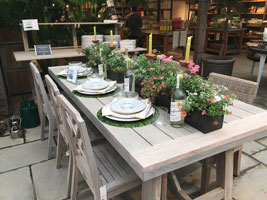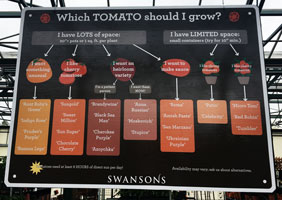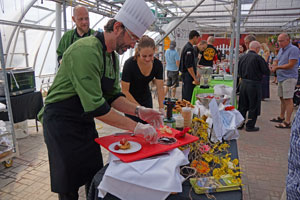10/1/2017
Appealing to Foodies
Bridget Behe & Heidi Lindberg
Many people love to eat and most of them hate to eat alone. Eating has always been a social activity and appears to be gaining ground in helping our industry to make food growing a more social activity.
The Serious Eats website reported that the former
New York Magazine food critic Gael Greene appears to have used the word “foodies” in print first in 1980. Regardless of the origin of their name, they’re growing in numbers across the globe. How can the retail garden center appeal to the foodie and entice them to grow some of their own food? How can plant retailers help their customers enjoy more social aspects of growing and eating food?
Get Them Early in the Season
Tomatoes, peppers, basil and parsley are the big four crops most consumers are familiar with and feel the desire to grow or at least attempt to grow. The leap from growing container to table is closer for herbs than vegetables, so herbs tend to be the “gateway” plant for so many first-time plant buyers who are also foodies. They know what basil looks like on the plate and in the pot. Basil plants they buy in the garden center are just ready to be picked and eaten—now that’s instant gratification.
Tomatoes or peppers will take time to set fruit and ripen. Merchandise some larger plants with fruit already set, at an appropriately high price point, and they should sell well to those who can’t wait for the first fruits.
Consider smaller cultivars and planters for smaller space gardening like you may find on patios and porches. Most consumers aren’t buying flats of vegetables and don’t have the time or space to grow large gardens. How can your garden center’s product mix be adapted? Start the smaller cultivars earlier so they’re closer to maturity for spring sales. More mature plants merchandised in larger containers may help. Be sure to cross-merchandise the automated watering systems you might have for sale nearby to help address that question of “who’ll water my plants while I’m gone?” Integrate a tomato with lettuce or even edible flowers. Do cross those botanical lines and introduce customers to new plants and new uses.

Demonstrate how to use the herbs or vegetables by merchandising several large display containers for consumers to see. Invite some local chefs into the garden center to show and share preparation ideas for fruits, vegetables and herbs. Chef demonstrations may also build into a class or workshop later in the season, when produce is more abundant and garden center sales are low. Classes may be for adults only and include a wine or beer pairing with dishes. An intergenerational class might pair grandparents or parents with kids, creating bite-sized and kid-friendly vegetable treats.
Pictured: A table setting designed to appeal to foodies at Terrain in Glen Mills, Pennsylvania. Photo credit: Jessica DeGraaf
A “Tomatofest” might feature a few local chefs who each make a different dish with tomatoes. Admission tickets may carry a fee (to pay for the cost of materials and tastings), but these festivals can bring in foodies of all ages and present them with another opportunity to buy later-season veggies or herbs. It’s a good opportunity to merchandise that second crop of basil, spinach, kale or chard, too. Many garden centers don’t take advantage of that possible (but short) second season: usually from July through October, depending on where in the country your garden center is located.
 Get Creative with Signage
Get Creative with Signage
With the abundance of choices, tomato or pepper cultivars may seem overwhelming. How is a first-timer, or even an experienced gardener, expected to make choices? Creative, eye-catching signs can help even the most time-pressed shopper identify the type of tomato or vegetable they want: by use. How do you plan to use the tomato or pepper? A fun segue to the vegetable area isn’t a sign as much as it is a symbol: set the table! Demonstrate the use of veggies by setting a table (maybe a large wooden picnic table or a small bistro table for two?) in or near the vegetable section. Adorn the table with placemats, dishes and glassware (hot glued to the top or mats, if necessary) to get the consumer thinking about eating their vegetables and herbs.
Pictured: This sign at Swanson’s in Seattle, Washington, provides some great guidance on tomato selection. Photo credit: Jessica DeGraaf
Get Social
Eating is social, so be sure your social media specialist is ready for posting on all your social media outlets. What’s good fodder for those social media outlets like Facebook, Twitter, Instagram, and Snapchat? Firsts, kids, ugly fruit or unusual shaped fruits or vegetables are always good bets. Encourage your customers to post their first tomato or pepper of the season. Foodies tend to have a competitive side, so sharing those “firsts” can bring some attention to your store as the one that supplied that plant racing toward the finish line. For some vegetables, the “largest” competition can be fun. Zucchini seem to always grow faster than goldfish, so perhaps that’s something consumers want to post about.
Many kids ages 5 to 10 have the attention span and interest to grow some plants. Here, again, is a rich opportunity for the foodie parent to get their child (or grandchild) involved in the garden. Encourage your customers to post images of the fun they’re having with their children growing (and eating!) fresh vegetables.
The key for these contests is to make them social, fun and bring them back to your garden center. It isn’t a push for sales, but an invitation to share the fun and enjoyment that your garden center helped to bring into their lives. Make it fun, keep it light, but also have a few rules (win only one competition per season) and give away a nice prize (gift certificate to your garden center).
 Mmmm, Tasty
Mmmm, Tasty
Later in the summer when produce is abundant, consider offering workshops or going a step further. Do you want to host a “best tomato chef” competition with judges and an audience? How about a “pesto festo” where chefs compete to make the best pesto? What about inviting food trucks to your parking lot and asking them to make or feature a product with tomatoes (or peppers or spinach or some other vegetable or herb?). Be sure to capture images and feature the events on your social media.
Pictured: Chefs prepare a strawberry brunch at Heeman’s Garden Centre in London, Ontario, Canada. Photo credit: Will Heeman
Foodies are a fun consumer group to target. Consider when they’re planting and eating their crops in order to plan activities and marketing around them. Remind them with visuals that these crops are meant to be eaten and enjoyed by setting a table nearby. For them, the “proof is in the tasting,” so having those tasting events will be essential to sales next year. Make your garden center the source of fun, inspiration and information to make the novice and experienced foodie productive in the garden!
GP
Heidi Lindberg is Greenhouse and Nursery Extension Educator with Michigan State University Extension. Dr. Bridget Behe is a Professor of Horticulture at Michigan State University specializing in marketing horticultural crops. They can be reached at wollaege@anr.msu.edu and behe@anr.msu.edu.
Did you miss the first installment? You can find it in the September issue of Green Profit. Look online at www.greenprofit.com for a digital version of the magazine to see the story “Socializing Gardening.” Look for the next installment in the November issue!